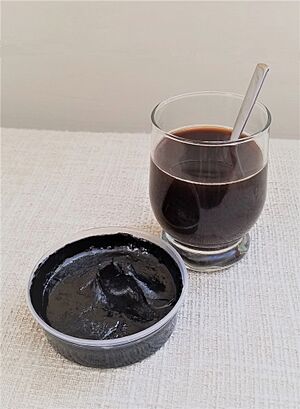Shilajit facts for kids
Shilajit (Sanskrit: शिलाजीत; lit. conqueror of mountain, 'conqueror of the rocks'), salajeet (Urdu: سلاجیت), mumijo or mumlayi or mumie is an organic-mineral product of predominantly biological origin, formed in the mountains (in mountain crevices and caves).
A blackish-brown powder or an exudate from high mountain rocks, often found in the Himalayas, the Pamir Mountains, Afghanistan, (primarily in Gorno-Badakhshan, Tajikistan), (Karakoram, Gilgit-Baltistan in Pakistan, Nepal, Bhutan, the Caucasus Mountains within Russia, Altai, Central Asia, Iran, Mongolia and in southern Peru, where it is called Andean shilajit. The peoples of the East used shilajit in folk and non-traditional (alternative) medicine (Ayurveda, Chinese, Tibetan). Shilajit is sold both in dry extract form and in dietary supplements, but there is no good evidence that shilajit has any beneficial effects on human health.
History
Since ancient times, shilajit has been a folk medicine in Afghanistan, India, Iran, China, Pakistan, Nepal, Central Asia and Tibet. Shilajit has been used as a folk medicine and in alternative medicine for more than four thousand years. The healing effects of shilajit for different diseases is mentioned in the works of Aristotle, Razi, Biruni, Ibn Sina and others.
D'Herbelot, in his 1821 publication, stated that the Persians used the substance called mumiay, or mummy, as a potent cure-all to address broken bones and disease.
Distribution
Deposits of shilajit are found in many mountainous regions of the world. Research by the Central State Geographical Exploration Center “Tsentrquartz Gems” has shown that deposits of shilajit, despite the wide geography of their location, are very rare, and the reserves of raw materials in them are limited. It is found in calcareous, metamorphic rock, and sedimentary rocks (from Proterozoic to Quaternary) in Central Asia, Tuva, at the Lake Baikal, in the Caucasus and other regions. It is more often found in the Himalayas, Tibetan Plateau, mountains of the Arabian Peninsula, Iran, Mongolia, Myanmar.
The substance is known by different names, including Salajeet (Urdu: سلاجیت) in Pakistan, μούμια (in Greek), mumiyo or mumie (Russian: Мумиё), brag-shun or barakhshin ("oil of the mountains" in Mongolia and southern Russian Siberian regions near the Sayan Mountains such as Khakassia and Buryatia), rock sap or rock juice (in Tibet, Central Asia, Himalaya, Pamir and Altai), asphalt, mineral pitch, Jew’s pitch, slag or mineral wax (in English), silajita or silajatu (in Bengali), hajarul-Musa or araq-al-jibal (in Arabic), myemu, moomiaii or mumnaei (in Persian), Mumie (in German), kao-tun ("blood of the mountain" in Myanmar) and "blessing of nature" (Nepal).
Formation
It has also been believed that it is formed as a result of the decomposition of oil rocks by microorganisms. Chemical composition of organic part of the extract (about 50% carbon and 10% hydrogen) supports the oil origin hypothesis. According to other analysis, shilajit is of plant origin and, most likely, is the product of very slow decomposition of plant matter. Some researchers hypothesize that shilajit is produced by the decomposition or humification of latex and resin-bearing plant material from species such as Euphorbia royleana and Trifolium repens over a period of centuries.
Composition
Although shilajit is sometimes referred to as a mineral tar or resin, it is neither. It is a highly viscous substance like a tar or resin, that is very dark brown or black in color, but unlike these is readily soluble in water but insoluble in ethanol. It contains more than 20 elements, including Ca, Mg, Na, Fe, Cr, Pb. It also contains solid paraffin hydrocarbons, proteins, carbohydrates, amino acids, fatty acids, and alcohols. The mineral content is 15–20%, along with trace elements including selenium.
Shilajit is rich in nutrients such as mineral salts, amino acids, and other organic components including benzoic acid, hippuric acid, fatty acids (myristic acid, stearic acid, oleic acid, petroselinic acid, linoleic acid, lauric acid, saturated fatty acids), ichthyridine, salicylic acid, resins, triterpenes, sterols, aromatic carboxylic acids, 3,4-benzocoumarins, amino groups acids, phenolic lipids, latex, albumin, sterols, tea polyphenols, phenolic lipids, dibenzo-alpha-pyrones (DBP), and dibenzo-α-pyrone chromoproteins (DCPs).
Shilajit is composed of 60–80% humic substances such as humic and fulvic acids.
Studied by analytical methods, shilajit samples from the Himalayas (5.1 kDa), Altai (8 kDa), Tian Shan (7.5 kDa), Dzungarian (9.0 kDa), demonstrated that it consists of two principal components: the high-molecular part is fulvic nature of sample as typical peat fulvic acids (sample from Sakhtysh Lake, Russia), and the low-molecular part represents a range of vegetative and animal metabolites such as methyldiaminocyclohexane, shikimic acid, hippuric acid, quinic acid, hydroxyhippuric acid, and methyldiaminocyclohexane dimer.
Health effects
Although touted for use in folk medicine, there is no good evidence that shilajit has any beneficial effects on human health.
Varieties
The composition of shilajit varies by location and appearance:
- Coprolitic (mumiyo-saladji, Pamir and Altai mumiyo, mumiyo-asil, etc.) are fossilized phyto- and zooorganic remains mixed with fragments and grus of rocks and soil formations. The content of extractive substances in coprolite shilajit ranges from 10 to 30% or more.
- Shilajit-bearing breccias are large-clastic rocks (more often, fissured limestones) cemented by shilajit-bearing clay mass. The content of extractive substances is 0.5–5.0%.
- Evaporite shilajit occurs in formations of streaks, icicles and shiny black or gray dull, thin films that stain the roofs and walls of caves, niches, grottoes and other large cavities. Its extraction is difficult.
Shilajit occurs in different colors and grades according to the type of metal contained: red (sauvarna shilajit) with gold, white (rajat shilajit) with silver, blue (tamra, with copper shilajit) and iron-containing black (lauha shilajit shilajit). Of these, black shilajit containing gold is the rarest and is considered to have the best curative effect. In nature, shilajit containing iron is used most in traditional medicine.
Mumioids are a group of natural formations resembling shilajit in appearance. The group includes ozokerite, saltpeter, fossilized vegetable resins and gums, mountain wax, white, stone and mountain oils, Antarctic shilajit, lofor, or aqua bitum.
See also
 In Spanish: Shilajit para niños
In Spanish: Shilajit para niños



